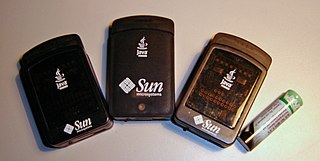
A wearable computer, also known as a body-borne computer, is a computing device worn on the body. The definition of 'wearable computer' may be narrow or broad, extending to smartphones or even ordinary wristwatches.
Draper Laboratory is an American non-profit research and development organization, headquartered in Cambridge, Massachusetts; its official name is The Charles Stark Draper Laboratory, Inc. The laboratory specializes in the design, development, and deployment of advanced technology solutions to problems in national security, space exploration, health care and energy.

Infineon Technologies AG is Germany's largest semiconductor manufacturer. The company was spun-off from Siemens AG in 1999. Infineon has about 58,600 employees in 2023 and is one of the ten largest semiconductor manufacturers worldwide. In 2023 the company achieved sales of €16.309 billion.

Analog Devices, Inc. (ADI), also known simply as Analog, is an American multinational semiconductor company specializing in data conversion, signal processing, and power management technology, headquartered in Wilmington, Massachusetts.
Smartdust is a system of many tiny microelectromechanical systems (MEMS) such as sensors, robots, or other devices, that can detect, for example, light, temperature, vibration, magnetism, or chemicals. They are usually operated on a computer network wirelessly and are distributed over some area to perform tasks, usually sensing through radio-frequency identification. Without an antenna of much greater size the range of tiny smart dust communication devices is measured in a few millimeters and they may be vulnerable to electromagnetic disablement and destruction by microwave exposure.

TinyOS is an embedded, component-based operating system and platform for low-power wireless devices, such as those used in wireless sensor networks (WSNs), smartdust, ubiquitous computing, personal area networks, building automation, and smart meters. It is written in the programming language nesC, as a set of cooperating tasks and processes. It began as a collaboration between the University of California, Berkeley, Intel Research, and Crossbow Technology, was released as free and open-source software under a BSD license, and has since grown into an international consortium, the TinyOS Alliance.

An inclinometer or clinometer is an instrument used for measuring angles of slope, elevation, or depression of an object with respect to gravity's direction. It is also known as a tilt indicator, tilt sensor, tilt meter, slope alert, slope gauge, gradient meter, gradiometer, level gauge, level meter, declinometer, and pitch & roll indicator. Clinometers measure both inclines and declines using three different units of measure: degrees, percentage points, and topos. The astrolabe is an example of an inclinometer that was used for celestial navigation and location of astronomical objects from ancient times to the Renaissance.

Sun SPOT was a sensor node for a wireless sensor network developed by Sun Microsystems announced in 2007. The device used the IEEE 802.15.4 standard for its networking, and unlike other available sensor nodes, used the Squawk Java virtual machine.

MediaTek Inc. is a Taiwanese fabless semiconductor company that provides chips for wireless communications, high-definition television, handheld mobile devices like smartphones and tablet computers, navigation systems, consumer multimedia products and digital subscriber line services as well as optical disc drives.

Mike A. Horton is an American engineer and founder of a company producing sensor technology and sensor-based systems.
Dust Networks, Inc. is an American company that specializes in the design and manufacture of wireless sensor networks for industrial applications including process monitoring, condition monitoring, asset management, environment, health and safety (EHS) monitoring, and power management. They were acquired by Linear Technology, Inc in December 2011, which in turn was acquired by Analog Devices, Inc. in 2017. The Dust Networks product team operates in the IoT Networking Platforms group of Analog Devices.
SensorDynamics was a European semiconductor and MEMS company specialized in developing and manufacturing high-volume micro- and wireless semiconductor sensor products for applications in automotive, industry and high-end consumer sectors. The company was acquired by Maxim Integrated in 2011 for $164 million. SensorDynamics developed and produced custom-made designs and standard components for use in vehicle stabilization, occupant protection, navigation systems, keyless go systems and autonomous energy generators for wireless and battery free controllers for industrial, automotive and high-end consumer application. With its headquarters in Graz, Austria, SensorDynamics had offices in Italy and Germany and a worldwide sales and distribution network. The company employed about 130 people in 2011.
Sumitomo Precision Products Co., Ltd. is an integrated manufacturer of aerospace equipment, heat exchangers, hydraulic controls, wireless sensor networks, sensors, micro-electronics technology, and environmental systems. The aerospace division supplies its products to aerospace industries worldwide, including Boeing, Airbus, Bombardier, and Embraer.
Xsens Technologies B.V. is a supplier of 3D motion capture products, wearable sensors and inertial sensors based upon miniature MEMS inertial sensor technology.
Kionix, Inc. is a manufacturer of MEMS inertial sensors. Headquartered in Ithaca, New York, United States, the company is a wholly owned subsidiary of ROHM Co., Ltd. of Japan. Kionix developed high-aspect-ratio silicon micromachining based on research originally conducted at Cornell University. The company offers inertial sensors, and development tools and application support to enable motion-based gaming; user-interface functionality in mobile handsets, personal navigation and TV remote controllers; and hard-disk-drive drop protection in mobile products. The company's MEMS products are also used in the automotive, industrial and health-care sectors. Kionix is ISO 9001:2008 and TS16949 registered.

CEA-Leti is a research institute for electronics and information technologies, based in Grenoble, France. It is one of the world's largest organizations for applied research in microelectronics and nanotechnology. It is located within the CEA Grenoble center of the French Alternative Energies and Atomic Energy Commission (CEA).

Tower Semiconductor Ltd. is an Israeli company that manufactures integrated circuits using specialty process technologies, including SiGe, BiCMOS, Silicon Photonics, SOI, mixed-signal and RFCMOS, CMOS image sensors, non-imaging sensors, power management (BCD), and non-volatile memory (NVM) as well as MEMS capabilities. Tower Semiconductor also owns 51% of TPSCo, an enterprise with Nuvoton Technology Corporation Japan (NTCJ).

ecobee is a Canadian founded home automation company that makes smart thermostats, temperature and occupancy sensors, smart light switches, smart cameras, and contact sensors. They were acquired by the American company Generac Holdings in 2021.










